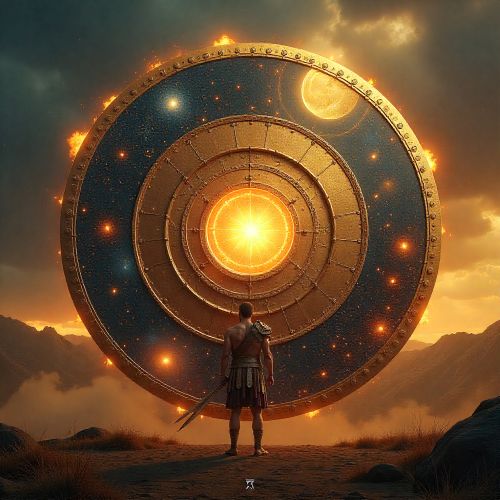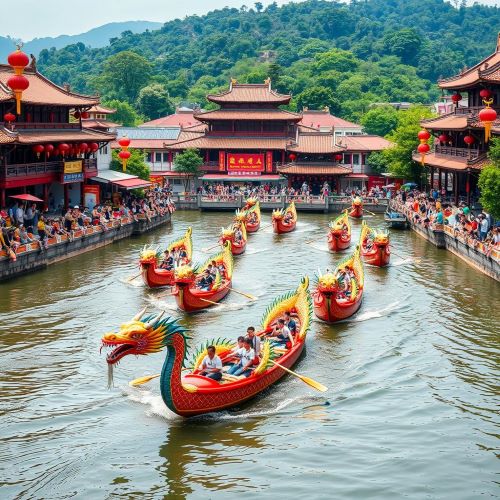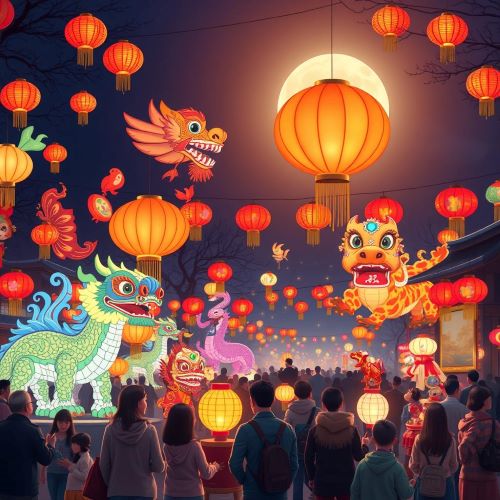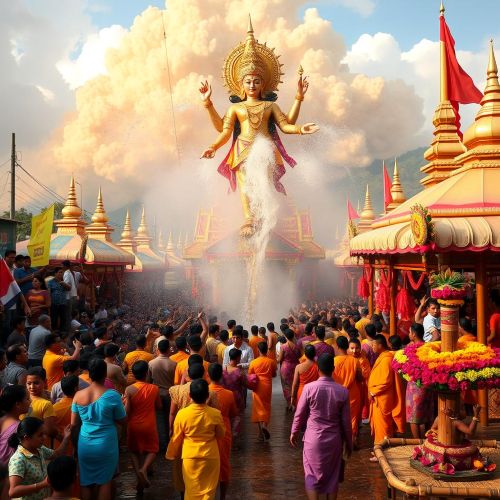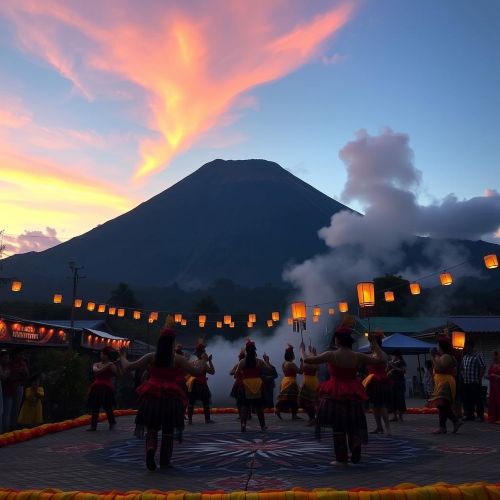Songkran : The Water Festival
At a glance
| Description | |
|---|---|
| Location | All over Thailand |
| Country | Thailand |
| Dedicated To | Seven Songkran Goddesses |
| Duration | 3 days |
| Time of Year | April |
Introduction
Songkran, Thailand’s traditional New Year festival, is celebrated annually from April 13 to 15. Known worldwide for its joyous water fights, Songkran holds much deeper cultural and spiritual meaning. The word Songkran comes from the Sanskrit term saṅkrānti, meaning “transition,” signifying the sun’s entry into Aries and the beginning of a new astrological cycle. This cosmic passage reflects renewal, cleansing, and fresh beginnings — themes woven throughout the celebrations.
Although Thailand officially adopted January 1 as the start of the new year in 1940 to align with the Gregorian calendar, Songkran remains the heart of the Thai calendar. Falling just after the rice harvest, it is a period when families reunite, communities honor Buddhist traditions, and people reflect on both gratitude and renewal. The duality of joy in the streets and serenity in temples captures the soul of Songkran, making it both a national holiday and an internationally recognized cultural treasure.
Connection with Mythology
Songkran is not merely seasonal; it is rooted in Buddhist folk legends and Thai cosmology. The most famous story tells of Thammabal Kumara, a child blessed with extraordinary wisdom, who was challenged by the Sun God Kabil Maha Phrom. After losing the contest of riddles, the deity was beheaded. His head was so powerful it could not be discarded without destroying the world. If it touched the earth, flames would consume it; if cast into the sea, waters would dry; if lifted into the sky, drought would follow. To prevent disaster, his seven daughters — known as the Nang Songkran or Songkran Goddesses — took turns carrying the head in an annual celestial procession.
This myth explains why each year of Songkran is presided over by one of these goddesses, determined by the weekday on which Maha Songkran begins. Each goddess has distinct attire, mounts, and symbolic items, representing cosmic order and seasonal fortune. For example, Tungsa Devi, who represents Sunday, rides Garuda and carries a discus and conch, while Kirini Devi, tied to Thursday, rides an elephant with an elephant goad and gun. The appearance of each goddess is believed to influence yearly predictions about weather, harvest, and prosperity.
In many regions, these goddesses are celebrated through parades, temple decorations, and ceremonial displays, ensuring that the ancient myth remains part of the living culture. This blend of legend, astrology, and seasonal rhythm shows how Songkran embodies more than festivity — it mirrors the cosmic harmony of Thai belief systems.
Main Activities
Songkran’s modern image may be dominated by lively street water fights, but its traditional practices remain deeply spiritual and family-centered.
The water rituals carry symbolic weight, signifying purification and renewal. Families and communities pour scented water over Buddha statues in temples, washing away the past year’s misfortunes. This same act of respect extends to elders during the Rod Nam Dum Hua ceremony, when younger generations pour water over the hands of parents and grandparents to seek blessings and forgiveness.
Merit-making is central to Songkran. Devotees offer food to monks, release fish and birds, or build sand pagodas in temple courtyards, each act believed to generate spiritual merit for the coming year. Cleaning homes before Songkran is another tradition, symbolizing the removal of misfortune and preparation for good luck.
Cultural festivities include parades featuring floats with the year’s presiding Songkran Goddess, as well as traditional dances and pageants like the Miss Songkran competition, where contestants wear ornate Thai attire. These community activities highlight both artistic expression and cultural preservation.
The water play, often the most visible part of Songkran, has roots in these purifying rituals. Over time, the practice of gently pouring water has evolved into large-scale public festivities, where entire streets transform into arenas of joyful splashing. In cities like Chiang Mai and Bangkok, the celebrations draw participants from across the world, merging tradition with modern fun.
Importance in Cultural History
Songkran is a cultural cornerstone that reflects Thailand’s spiritual values, agricultural rhythms, and social structures. Historically, the festival marked the end of the dry season and the beginning of the monsoon, symbolizing fertility and abundance. The use of water as a central theme mirrors its vital role in both agriculture and spirituality.
The festival has always been tied to Buddhist ethics of humility, compassion, and renewal. In the royal courts of Ayutthaya and later Bangkok, Songkran was observed with elaborate rituals, including sprinkling water on sacred Buddha images, performing astrological readings, and making offerings to monks. In rural communities, the focus was on family reunions and community cooperation, ensuring the traditions resonated at every level of society.
Foreign observers such as Engelbert Kaempfer in the 17th century and Jean-Baptiste Pallegoix in the 19th century documented Songkran as a three-day event filled with both religious ceremonies and astrological predictions, underscoring its deep roots in Thai history.
The festival’s cultural significance was further validated in 2023 when UNESCO inscribed Songkran in Thailand on its list of Intangible Cultural Heritage of Humanity. This global recognition highlights Songkran not just as a national celebration, but as a living heritage that embodies universal values of renewal, respect, and joy.
Need a place to stay? Book your hotel room now!
International Appeal
Today, Songkran attracts millions of international visitors, making it one of Thailand’s most important cultural exports. Cities like Chiang Mai, known for their massive parades and temple ceremonies, and Bangkok, with its iconic Khao San Road festivities, have become global tourism magnets during April.
In 2025, the Maha Songkran World Water Festival is scheduled to feature over 100 events nationwide, with Bangkok’s Sanam Luang ceremonial ground as the centerpiece. These celebrations not only preserve tradition but also boost the Thai economy, generating billions of baht in revenue from tourism.
Songkran’s themes of renewal and gratitude resonate beyond Thailand. Variations of the festival are celebrated across Southeast Asia, including Myanmar’s Thingyan, Laos’ Pi Mai, and Cambodia’s Chaul Chnam Thmey. Even communities as far away as New York, Sydney, and London host Songkran events, organized by Thai diaspora communities. These international celebrations blend entertainment with cultural diplomacy, strengthening Thailand’s global identity.
However, the festival also faces challenges. The period of festivities is locally referred to as the “seven dangerous days” due to a spike in road accidents, often linked to alcohol consumption and motorbike use. In response, the Thai government has launched campaigns promoting safe celebrations while still honoring cultural practices.
Source
Charoenwong, S. (2018). Songkran: The Thai New Year Festival. Bangkok: Thai Cultural Heritage Press.
Keyes, C. F. (1994). Buddhism and National Integration in Thailand. Journal of Asian Studies, 53(4), 1029–1048. https://doi.org/10.2307/2059574
Swearer, D. K. (2010). The Buddhist World of Southeast Asia. Albany: State University of New York Press.
Tourism Authority of Thailand. (2022). Songkran Festival. Retrieved from https://www.tourismthailand.org
United Nations Educational, Scientific and Cultural Organization. (2021). Vesak Day. Retrieved from https://en.unesco.org/commemorations/vesakday
Frequently Asked Questions
Lorem ipsum dolor sit amet, consectetur adipiscing?
Lorem ipsum dolor sit amet, consectetur adipiscing elit. Praesent convallis vestibulum justo, ac tincidunt nunc vehicula quis. Nullam id dolor quis orci malesuada feugiat. Curabitur aliquet libero at urna ullamcorper, ac ultricies nulla dapibus.
Lorem ipsum dolor sit amet, consectetur adipiscing?
Lorem ipsum dolor sit amet, consectetur adipiscing elit. Praesent convallis vestibulum justo, ac tincidunt nunc vehicula quis. Nullam id dolor quis orci malesuada feugiat. Curabitur aliquet libero at urna ullamcorper, ac ultricies nulla dapibus.
Lorem ipsum dolor sit amet, consectetur adipiscing?
Lorem ipsum dolor sit amet, consectetur adipiscing elit. Praesent convallis vestibulum justo, ac tincidunt nunc vehicula quis. Nullam id dolor quis orci malesuada feugiat. Curabitur aliquet libero at urna ullamcorper, ac ultricies nulla dapibus.
Lorem ipsum dolor sit amet, consectetur adipiscing?
Lorem ipsum dolor sit amet, consectetur adipiscing elit. Praesent convallis vestibulum justo, ac tincidunt nunc vehicula quis. Nullam id dolor quis orci malesuada feugiat. Curabitur aliquet libero at urna ullamcorper, ac ultricies nulla dapibus.
Lorem ipsum dolor sit amet, consectetur adipiscing?
Lorem ipsum dolor sit amet, consectetur adipiscing elit. Praesent convallis vestibulum justo, ac tincidunt nunc vehicula quis. Nullam id dolor quis orci malesuada feugiat. Curabitur aliquet libero at urna ullamcorper, ac ultricies nulla dapibus.



